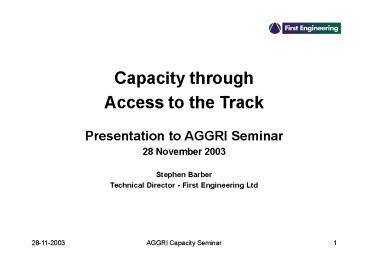Capacity through - PowerPoint PPT Presentation
1 / 12
Title: Capacity through
1
Capacity through Access to the
Track Presentation to AGGRI Seminar 28 November
2003 Stephen Barber Technical Director - First
Engineering Ltd
2
- Structure
- Current position
- access provision - actual and an ideal
- cost drivers
- Work in progress
- national system level
- route and area specific
- key lessons
- Opportunities
- Implications for planning and delivery
- Conclusions
3
- Current position - access provision
- Network has finite capacity, yet over time
increasing demands have been placed upon it - A small number of critical junctions routes
need more access - in Kent gt70 of delay minutes attributed to key
junctions - only 3 of access available at those
sites - But globally, current engineering access not
fully utilised
4
- Current position - compared to an ideal
- General Characterisation of Existing ROTR Work
Pattern
- Characterisation of Ideal ROTR Work Pattern
5
- Current position - cost drivers
- Short possession access not effective or
efficient - Long possessions give most efficient use of
engineering resources - optimum length driven by
engineering activity - Performance regime incentivises under-planning
- Clear need for industry business case
optimisation - value of running incremental trains vs.
incremental cost of engineering work in shorter
access windows - Unconstrained Projects - major impact on
maintenance and renewal plans - Renewals - item / scope change - and then
programme slip
6
- Work in progress - national system level
- Network Access Unit (Leeds) established to
co-ordinate delivery of engineering access - Integrated Planning Units (IPUs) taking overall
view of possessions use within Network Rail
Regions - Area planning Teams - local ownership from T-46
- Collection of industry KPIs on possession
performance - Maximise use of individual possessions
- Optimum value tools - e.g. POET (possession
optimisation efficiency tool)
7
- Work in progress - route specific
- Targeting best industry outcomes for a particular
route - London-Norwich
- London-Brighton
- Bristol-Birmingham
- Southampton West Midlands Action Team
- Scotland RSSB
- 2004/05 timetable wins in 2003/04 where
possible - cross industry teams developed plans
- NR, IMCs, TOCs, FOCs and RSSB
8
- Work in progress - key lessons 1
- Tri-partite meetings between IMC/NR/TOC are
essential to achieve best results for possession
requirements - Annual workload should be assessed to identify
cyclical maintenance for key junctions and plan
engineering access accordingly - Renewals plan should be fixed when cyclical
maintenance is planned - at the latest - Resource utilisation should be considered over
wide geographical scope main trunk routes at
weekends, suburban commuter routes in midweek
nights
9
- Work in progress - key lessons 2
- Treat cyclical possessions and work within them
as a project - plan, monitor and control work accordingly
- Main routes with 3 tracks - access for
patrolling inspection is problematic - must work with TOCs to achieve optimum value
solution - Look at safety and efficiency of site access
- provide additional and improved access points
where these would give significant extra site
working time
10
- Opportunities
- SWAT has identified real efficiency savings for
2003/04 - 58 increase in track mile hours, 32 fewer
possessions - weekend blocks are c100 more productive c20
of work currently done at the weekend - Scotlands plan for maintenance from 2005
- reduces total engineering access hours
- increases work hours whilst keeping paid hours
constant - weekend work moves to 11 hour shifts, weeknight
access to 7 hours shifts - unlocks increases in output efficiency, volume
and quality - facilitates reductions in delays and TSRs
11
- Implications for planning and delivery
- Need clear view on projects and renewals
workbanks - and plans that are stable within industry
planning horizons - Need to consider broad patterns of access
relevant to different types of route - site optimisation model gives best possession
times for mtce renewal work - but needs better
train value info - but also optimise overall demand for resource
- Blockades often necessary and most efficient
solution - pre-determined formula giving visibility on cost
of blockades would remove significant levels of
risk
12
- Conclusions
- Finite capacity - used for train paths or
engineering - two issues cannot be separated - Utilisation strategies must balance effectiveness
and efficiency of engineering access against the
value of the transport opportunities foregone - Access optimisation needs clear view of costs and
values of passenger traffic, freight traffic and
engineering work - Maintenance, renewal and project work is
fundamentally linked - planning across all 3 must
be integrated - Optimal practical solutions come from tri-partite
dialogue between engineers, network controllers,
and TOC/FOCs































